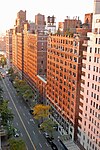Calvary Baptist Church (Manhattan)
1847 establishments in New York (state)Baptist churches in New York CityChurches in ManhattanEvangelical megachurches in the United StatesMegachurches in New York (state) ... and 3 more
Midtown ManhattanReligious organizations established in 1847Skyscrapers in Manhattan

Calvary Baptist Church is a Baptist independent church, located at 123 West 57th Street between the Avenue of the Americas (Sixth Avenue) and Seventh Avenue, near Carnegie Hall in Midtown Manhattan, New York City. The 123 W. 57th Street facility is under renovation - until the renovation is complete, Calvary will gather every Sunday at 10 a.m. at Assembly Hall on the Manhattan campus of Hunter College, located at 695 Park Ave, New York, NY 10065, North Building, E. 68th St. The church also gathers online every Sunday morning at live.cbcnyc.org.
Excerpt from the Wikipedia article Calvary Baptist Church (Manhattan) (License: CC BY-SA 3.0, Authors, Images).Calvary Baptist Church (Manhattan)
West 57th Street, New York Manhattan
Geographical coordinates (GPS) Address Website External links Nearby Places Show on map
Geographical coordinates (GPS)
| Latitude | Longitude |
|---|---|
| N 40.765197 ° | E -73.978431 ° |
Address
Calvary Baptist Church
West 57th Street 123
10019 New York, Manhattan
New York, United States
Open on Google Maps









